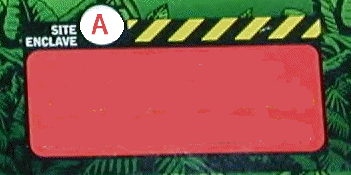The Early Cambrian
By the Dinosaur Collector
110609
| More than 1/2 BILLION years old, the fossils of the Burgess Shale fauna preserve for us an intriguing glimpse of early animal life on Earth. These fossils are named after a Cambrian rock formation (the Burgess Shale) that is located in the western Canadian Rockies. This is our first sight of modern multicelled creatures. Most of the animals have few hard parts and do not normally create fossils. | Sidneyia is a large , up to 13cm, predator. The spines along the walking legs were used to catch and eat ostracods and trilobites. Canadapisis crustracean digging in sediment for food. Over 4000 fossils were found. Aysheaia is a loboform and is most likely a memeber of the minor Phylum Onychophora. | |
| Photo of the Burgess Shale Diorama at National Museum of Natural History Museum , Smithsonian Institution. | Photo of the Burgess Shale Diorama at National Museum of Natural History Museum , Smithsonian Institution. |
| Opabinia with its five eyes is a strange looking one indeed. Wielding a long flexible proboscis tipped with grasping spines. It was about 3 inches long. It may be related to
|
||
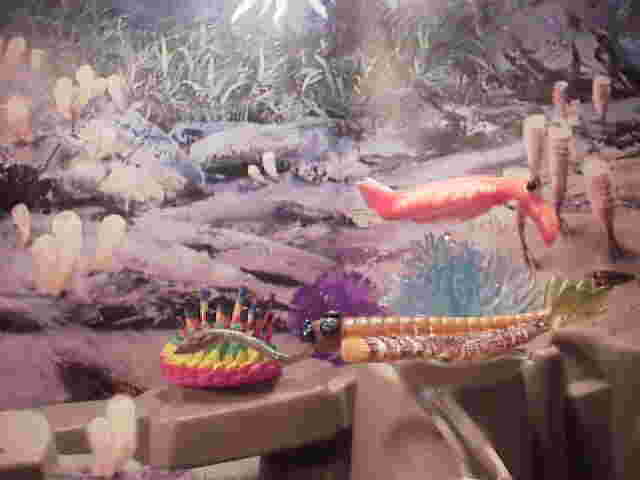 |
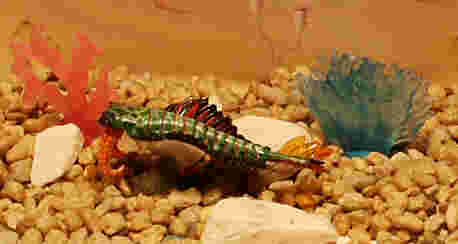 |
|
| UHA Anomalocaris |
| Haikouella is a probable chordate. It does not have bones or a movable jaw, but it otherwise resembles vertebrates. The animal is 20 to 30 mm (40 mm max) in length and has a head, gills, brain, notochord, well developed musculature, heart and circulatory system. It has a bent caudal projection of the notochord that might be a primitive tail fin. It might have a pair of lateral eyes. Very small (0.1 mm) structures that are probably pharyngeal teeth are present in the body cavity. A few specimens display dorsal and ventral fins. | Olenoides is decribed by Stephen Gould in his book 'Its a Wonderful Life' as a standard trilobite The long, curved antennae were well preserved in the Burgess Shale. The middle legs, near their base, bore a series of spines that could be used to grasp the soft-bodied animals it preyed on and then to move them forward toward the mouth. The thin limbs tell us that this was not a swimmer. Instead, it was an active predator and scavenger moving about the muddy seafloor. | |
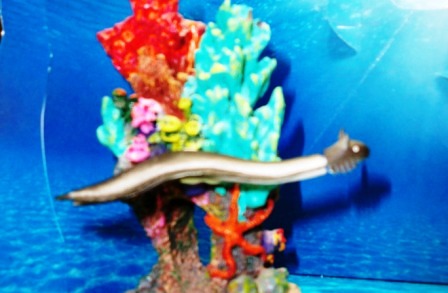 |
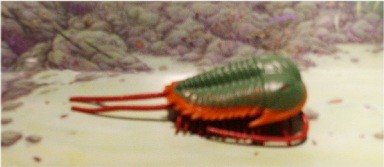 |
|
| Haikouella from NHK's popular "Earth Evolution Encyclopedia" TV series | Olenoides from the ROM series |
| Pleurocystites is a good example of the sedentary filter feeders that dominate Paleozoic seas. Echinoderms include crinoids, starfish and sea urchins. They decline sharply at the end of the Paleozoic. Pleurocystites is an echinoderm that lived in the Late Ordovician. Opabinia probably used its proboscis to search the sediment for food particles and pass them to its mouth. Since there is no sign of anything that might function as jaws, its food was presumably small and soft. modern tardigrades may be Opabinia’s closest living evolutionary relatives. They may also be related to loboforms. | Originally the Hallucigenia was thought to have stood on its spines, with the tentacles upward. Later studies have shown that the "tentacles" are actually feet, It is less than three millimeters long, making it one of the smaller creatures in the Burgess Shale. At one end there is a bulbous "head" which is a round mass. This connects to the cylindrical trunk of the Hallucigenia, which, on the top has seven pairs of spines pointing upward and outward. These conical spines are embedded into the trunk, and are fairly long when compared to the rest of the Hallucigenia. Below each pair of spines there is a tentacle except that the last tentacle is offset from the pair of spines. Behind these tentacles there are three pairs of much shorted tentacles, and then the trunk narrows and curves upward. The tentacles have pincers at their tips, and there is a hollow tube in each one which is connected to the gut. It and Aysheaia are thought to be loboforms and related to the velvet worms an obscure phylum of caterpillarish looking animals found in southern hemisphere. | |
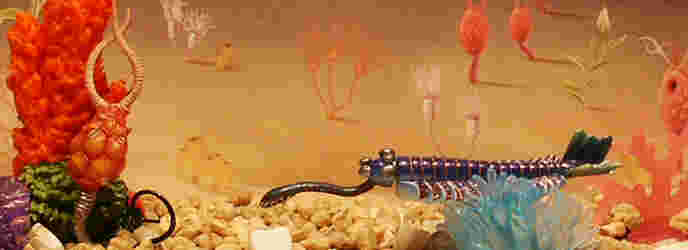 |
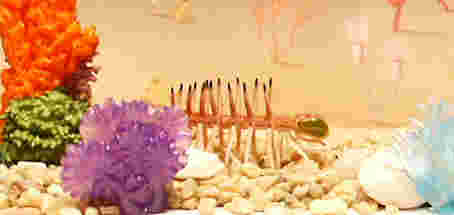 |
|
| UHA DinotalesPleurocystites and Opabina | UHA Dinotales Hallucigenia |
| Each of these little scales was attached with a root-like base and we assume Wiwaxia grew by molting these plates from time to time. Since there are none on the bottom (ventral) surface, the animal partly resembles the slug, a member of the mollusk family. A more recent relationship proposal is a relationship with an annelids. The sclerite being similar in microstructure to the chitinous bristles (chaetae) of earth worms. It did have an anterior jaw with two rows of teeth on the ventral surface, suggesting it was another bottom feeder. Fossil sizes range from 1/8 to 2 inches. | Recently Anomalocaris is grouped with loboforms along with Hallucigenia as anthropods. Originally the different parts were identified as 3 separate animals, trunk, jaws and front limbs were preserved separately. Only later was a connected specimen recovered. | |
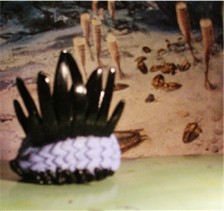 |
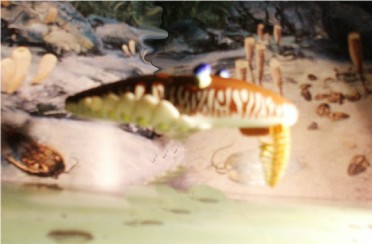 |
|
| ROM (Royal Ontario Museum) Wiwaxia | ROM (Royal Ontario Museum) Laggania |
Click on the Site A icon left for more diorama listed by location Click on the Site A icon to the right for Dioramas organized by period or by manufacturer.
